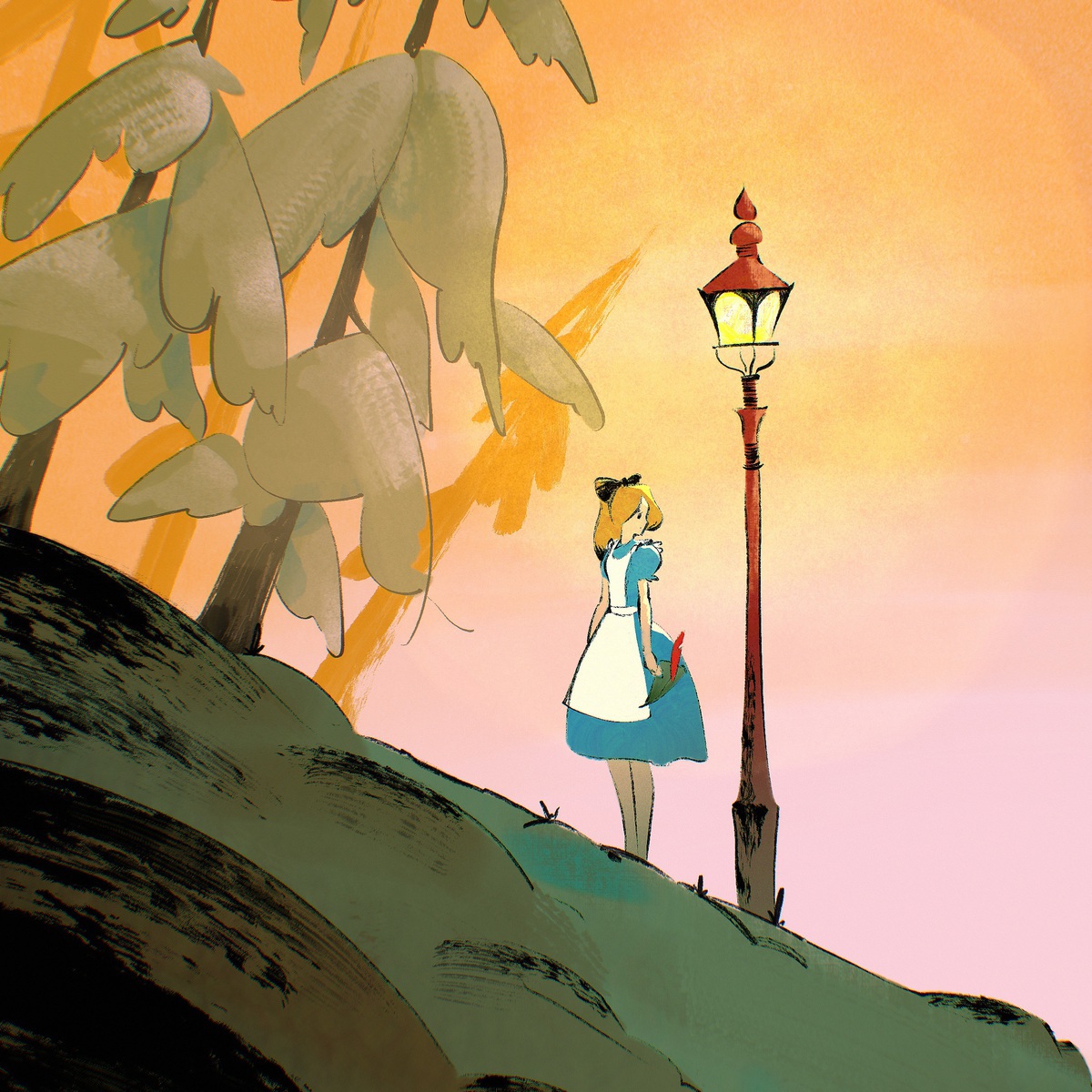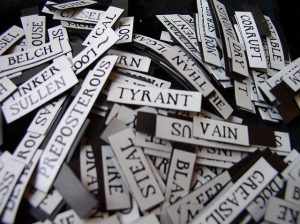
Growing Into Childishness
by Minty Plumstead | January 2, 2023
MY DEAR LUCY,
I wrote this story for you, but when I began it I had not realised that girls grow quicker than books. As a result you are already too old for fairy tales, and by the time it is printed and bound you will be older still. But some day you will be old enough to start reading fairy tales again. You can then take it down from some upper shelf, dust it, and tell me what you think of it. I shall probably be too deaf to hear, and too old to understand, a word you say, but I shall still be
your affectionate Godfather,
C.S. LEWIS[1]
Growing up isn’t easy. Suddenly, instead of ‘growing into’ hand-me-downs, we must start ‘growing out’ of things: out of toys, out of animated films, and out of ‘childish’ books. Too often, this change destabilises how we understand ourselves. We are like Alice, displaced from the familiar world into one that seems totally incomprehensible. Being stretched and compressed to fit in takes its toll.
‘‘‘Well! What are you?” said the Pigeon. […]
‘‘I – I’m a little girl,” said Alice, rather doubtfully, as she remembered the number of changes she had gone through that day.’[2]
When I was thirteen, I read Peter Pan and Wendy for the first time. However clichéd this may be, it was the summer before starting a new school – a school of complete (and in my eyes, threatening) strangers. I came to J.M. Barrie looking for something, the confirmation that childhood didn’t have to end. At thirteen, that was what he gave me. Peter Pan became a very close friend: to me he was just an uncomplicated sprite, a silhouette who promised he’d always be outside my window. Meeting the story at this age, I knew I was already older than most readers of fairy tales, and I flattered myself that I had unlocked every clue it held. Surely it didn’t go much deeper than the wonder of being a child forever.
As many readers will know, however, no book stays the same. Peter Pan remains my favourite. I’ve read it every year since, and every year it shows me something new, giving me the tools I need for that moment. I’ve grown up with it. Yet there is still shame attached to reading ‘childish’ literature after a certain age. We are expected to graduate from fairy tale stories to Young Adult novels, and then, if we’re brave, to the fastidious rows of stiff-collared Penguin Classics. But the more I have returned to these novels, the more I have noticed that writers like J.M. Barrie, C.S. Lewis, and Lewis Carroll do not construct their fantasy worlds as spaces impenetrable to the adult reader. Rather, these are writers subtly working to help us cross the border which divides Neverland, Wonderland, and Narnia from real life. They strive to console us that growing up, though inevitable, is not frightening – and that it necessarily involves a certain amount of being childish in order to do it right.
Peter Pan might be stubbornly opposed to growing up, but Barrie is certainly not. Something I could not appreciate at thirteen, but which I can discern now, is how Barrie guides us into releasing our clutch on childhood and the fantasy of its eternity. At first, we, like Wendy, are enchanted by the reckless and charming ideal of Peter, and don’t need asking twice to follow the Darling children out of the nursery window. The offer of Neverland is much more magnetic than the prosaic interior of No. 14, and so we shadow Peter as he glides from one world into another. Yet over the novel’s course, we are weaned from the romantic vision of living as forever-children in this seeming paradise, because Barrie nudges us imperceptibly from the perspective of the child reader to that of the wise grown-up. Unlike its Disney reincarnations, Barrie’s story refuses to finish on an indulgent note: the narrative lens does not pan away from a final goodbye, couched in unspoken guarantees of friendship.
Instead it provides a kind of epilogue, in which Barrie summarises the lives of every character who returned from Neverland to Victorian England, as they each become ‘grown up and done for’. We follow Wendy, who evolves from winning the first prize for general knowledge at school, to being married in white with a pink sash, to having a daughter called Jane. As Peter continues to forget the annual visits he promised her, her girlish obsession becomes ultimately no more to her than ‘a little dust in the box in which she had kept her toys’.[3] Even to us, by the end, he is little more. The selfishness and carelessness of Peter Pan was not something I would admit at thirteen, but I have come to recognise this as the heart of Barrie’s story. It’s only when we can acknowledge that the fairy boy is everything wrong with refusing to grow up, that we can come to terms with it ourselves.
If Peter Pan can teach us how to grow up, then C. S. Lewis’s The Chronicles of Narnia seek to teach us how, having done this, we can live well. Although it does so through an intricate web of Biblical parallels, there are still patterns of moral guidance for the child and adult reader alike, beyond the Christian template of teachings. This is partly because of the balance which he enacts between the sobering dimension of his educational purpose, and the mythologies and magic which are crafted to appeal to children. In this way, Lewis renders moral choices through a medium which will engage the younger reader, all the while hoping for later re-engagement at an age ‘old enough to start reading fairy tales again’, when readers might unpick his Christian messages.
As a child, I was spellbound by the transportive powers of the narrative. His Chronicles abound with the transformation of the ordinary into the extraordinary: spare-room wardrobes and nautical paintings can provide passages into an alternative reality, one in which animals can speak and are accompanied by fabulous creatures like fawns and centaurs. Lewis directs us, in this format of mixed fantasy and Christian allegory, to participate in imaginary action – to decide whether to defend the weak at our own risk, or whether to indulge our selfish desires. Alert to the paradigm of the wayward Christian, Aslan’s forgiveness of Edmund after he defeats the White Queen in The Lion, the Witch, and the Wardrobe embodies the doctrine of redemption earned through virtuous action, and a salvation that is open to all who repent. Yet in its basics, the same advice against selfishness recurs throughout the series in more purely mythical or fantastic forms, such as in Eustace’s metamorphosis for stealing from a dragon’s hoard in The Voyage of the Dawn Treader.
In one sense, Lewis’s literary project seems motivated by the desire to have us know his God in this fictional world, as he suggests in his fifth book:
‘‘‘Are – are you there [in the real world] too, Sir?” said Edmund.
‘‘I am,” said Aslan. ‘‘But there I have another name. You must learn to know me by that name. This was the very reason why you were brought to Narnia, that by knowing me here for a little, you may know me better there.”’ [4]
But on another level, these are spaces which, like Neverland, offer opportunities for testing and consolidating our understanding of ourselves – where we can know ourselves better. For the Pevensie children, to flourish in Narnia demands chivalric qualities reminiscent of Arthurian legend: qualities like bravery, honesty, open-mindedness, and compassion. It is Lewis’s fundamental hope that, like Edmund and Eustace, the two characters most changed by their adventures, we shall leave Narnia a little more sensitive to others. While we may absorb these lessons through the fantasy as children, they are illuminated by the act of re-reading as an adult, revealing that these novels have as much to teach us now as they did our younger selves.
While reading C.S. Lewis in a spiritual framework is dependent upon understanding the allegory, Lewis Carroll defies every attempt to interpret more than the surface value of his narrative. In fact, he undoes a lot of Lewis’s careful work, because whereas Lewis gives us a clear picture of good and evil, Carroll’s novels dismantle that adult impulse to put things into boxes. Alice’s Adventures in Wonderland devotes itself to making a mockery of adult logic, achieving this most obviously by taking idioms so seriously. From the Mouse reciting William the Conqueror’s history after the caucus race, because it’s ‘the driest thing’ he knows, to imagining what it would be like to draw ‘a muchness’, Carroll presents Wonderland as the child’s upside-down world.[5] By inventing a space driven by an alternative sense to ours, Carroll playfully asks who the mad ones really are: every creature belonging to Wonderland, or the one foreigner who questions what they all accept to be natural. This dynamic is clear in Alice’s conversation with the Mock Turtle:
‘‘‘The master was an old Turtle – we used to call him Tortoise –”
‘‘Why did you call him Tortoise, if he wasn’t one?” Alice asked.
‘‘We called him Tortoise because he taught us,” said the Mock Turtle angrily: ‘‘really you are very dull!”’ [6]
And we start to think that maybe we are very dull indeed. The wonderful thing about nonsense is that, if enough people believe it, it becomes a kind of sense. This is very entertaining for a younger reader like I was, as it articulates the difficulty of getting to grips with the nuances of adult speech. Carroll is simultaneously winking at the more grown-up reader by using his fantasy world to indirectly comment on affairs in the real one, like Barrie and Lewis. I have noticed now that Carroll reveals meaning to be not an objective constant, but a completely man-made consolation for what is ultimately an unmeaningful and unpredictable reality. This is made explicit in his second novel, Alice Through the Looking-Glass, when Alice accuses the Red Queen of nonsense to which she replies:
‘‘‘You may call it ‘‘nonsense” if you like,” she said, ‘‘but I’ve heard nonsense, compared with which that would be as sensible as a dictionary!”’[7]
What becomes clear is that the Red Queen challenges a black-and-white binary of sense and nonsense, by suggesting that meaning is achieved by relativity and not a fixed standard. Words, as Carroll’s Humpty Dumpty says, can mean whatever you want them to mean, and you can even lump two distinct words together and call it a portmanteau. It is in this way that Carroll helps us to cross the border between childhood and adulthood, by dissolving the idea that these are two separate spheres – he is like the White Rabbit who guides us down the rabbit hole, navigating a liminal space in which both sense and nonsense permeate each other. Carroll assures us that to imagine the wildly impossible is not madness. After all, these scenarios came straight from Carroll’s head, and he was an Oxford Mathematics professor. Nor does a ‘childish’ turn of mind make us mad, when reason is artificial anyway. Or, if these things do make us mad, at least the Tim Burton film reassures us that ‘‘all the best people are”.
Neverland, Narnia, and Wonderland are kingdoms of improbability, gated in these novels by portals to our reality. They exist outside the dominion of time, and often of sense. In their stories, they offer spaces for children to be rulers and agents of justice, determiners of their environments away from adult regulation. But they are certainly not exclusively for child readers. Even when Wendy can no longer fly, grounded like us with only the ‘‘sound of the surf” on Neverland still resounding through her, she continues to participate in the creation of Neverland by recalling her adventures for her daughter.[8] Because storytelling is a grown-up gift, and making sense of stories an adult art. Barrie showed me how to grow up. Lewis showed me how to live his version of an upstanding grown-up life. And Carroll showed me the most important lesson of all: that being a grown-up means keeping ‘‘through all [our] riper years, the simple and loving heart of [our] childhood”.[9] That’s why it’s important for me to dust off these books now and then, revisit their lands once in a while. Because sometimes being a grown-up does mean being a little bit childish. ∎
Words by Minty Plumstead. Art by Matthew Kurnia.
Bibliography
Barrie, J.M. Peter Pan ([1967] 2013). Penguin Group (USA) Inc.: New York; Penguin Books Ltd.: London.
Carroll, L. Alice’s Adventures in Wonderland and Through the Looking-Glass ([1958] 1966). Macmillan and Company Ltd.: London, Melbourne.
Lewis, C.S. The Last Battle ([1980] 2001) Collins: London.
Lewis, C.S. The Lion, The Witch, and The Wardrobe ([1980] 1985). Fontana Lions: London.
Lewis, C.S. The Voyage of the Dawn Treader ([1980] 2001). Collins: London.
[1] Lewis, C.S. Dedication ‘To Lucy Barfield’, from The Lion, The Witch, and The Wardrobe ([1980] 1985). Fontana Lions: London.
[2] Carroll, L. Alice’s Adventures in Wonderland and Through the Looking-Glass ([1958] 1966). Macmillan and Company Ltd.: London, Melbourne. Pp. 57.
[3] Barrie, J.M. Peter Pan ([1967] 2013). Penguin Group (USA) Inc.: New York; Penguin Books Ltd.: London. Pp.199.
[4] Lewis, C.S. The Voyage of the Dawn Treader ([1980] 2001). Collins: London. Pp. 271.
[5] Carroll, L. Alice’s Adventures in Wonderland and Through the Looking-Glass ([1958] 1966). Macmillan and Company Ltd.: London, Melbourne. Pp. 29, 79.
[6] Carroll, L. Alice’s Adventures in Wonderland and Through the Looking-Glass ([1958] 1966). Macmillan and Company Ltd.: London, Melbourne. Pp. 99.
[7] Carroll, L. Alice. ‘Through the Looking-Glass and What Alice Found There’, Alice’s Adventures in Wonderland and Through the Looking-Glass ([1958] 1966). Macmillan and Company Ltd.: London, Melbourne. Pp. 165
[8] Barrie, J.M. Peter Pan ([1967] 2013). Penguin Group (USA) Inc.: New York; Penguin Books Ltd.: London. Pp.8.
[9] Carroll, L. Alice’s Adventures in Wonderland and Through the Looking-Glass. ([1958] 1966). Macmillan and Company Ltd.: London, Melbourne. Pp. 132




